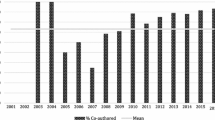Abstract
The generation of knowledge enables the development of adaptive capacities required by organizations that aspire to survive in competitive context; academic institutions are not oblivious to this. In fact, the generation and dissemination of scientific knowledge are ingrained within the DNA of university institutions, assuming knowledge creation as primary function to breed scientific publications. In this sense, the organizational study of social network structures turns to be a robust tool for the analysis and comprehension of formal or informal collaborative relationships engaged in the core of any social entity. Through the co-authorship analysis in scientific publications and the utilization of social network analysis (SNA) approach, the present paper examines the structure of influences that reigns in a particular university, identifying those authors who have been capable to generate, foster, and boost a relational network and the entirely intellectual capital of the institution. The conclusions unveil the prevalence of a non-cohesive, uncompleted, and inequitable social network, in which the academic category or status neither determines nor assures a key position within the network.



Similar content being viewed by others
Notes
Specifically, there are two members of the network—the holders (titular) of area 8 and 15—who have coauthored eight publications. They are followed by other three titular professors of area and one titular lecturer (of course, professor Alfonso Carlos Morales is among these academic professionals, along with TA-1, TA-26, and T-5) with 7 scientific papers published in collaboration with other colleagues.
References
Anklam, P. (2003). Knowledge management and the social network. In Knowledge Management Magazine. Retrieved March, 4 2013 from http://www.byeday.net/ona/documents/KM%20and%20the%20social%20network.pdf.
Barabási, A. L., Jeong, H., Ravasz, R., Neda, Z., Bishkek, T., Schubert, A., et al. (2002). Evolution of the social network of scientific collaboration. Physica A, 311, 590–614.
Barnes, J. A. (1972). Social networks. Reading, MA: Addison-Wesley.
Blau, P. M. (1994). Structural context of opportunities. Chicago: University of Chicago Press.
Borgatti, S. P., Everett, M. G., & Freeman, L. C. (1992). Ucinet IV: Network analysis software. Connections, 15, 12–15.
Borgatti, S. P., Everett, M. G., & Freeman, L. C. (2002). Ucinet for Windows: Software for social network analysis. Harvard, MA: Analytic Technologies.
Borgatti, S. P., & Halgin, D. S. (2011). Analyzing affiliation networks. In P. Carrington & J. Scott (Eds.), The Sage handbook of social network analysis (pp. 417–433). London: Sage.
Börner, K. (2007). Making sense of mankind’s scholarly knowledge and expertise: Collecting, interlinking, and organizing what we know and different approaches to mapping (network) science. Environment and Planning B: Planning and Design, 34, 808–825.
Breiger, R. (1974). The duality of persons and groups. Social Forces, 53, 181–190.
Casanueva, C., Escobar, P., & Larriaga, C. (2007). Red social de contabilidad en España a partir de los tribunales de tesis. Revista Española de Financiación y Contabilidad, 36(136), 707–722.
Choo, C. W. (1998). The knowing organization: How organizations use information to construct meaning, create knowledge, and make decisions. New York: Oxford University Press.
Crane, Diana. (1972). Invisible colleges: Diffusion of knowledge in scientific communities. Chicago, IL: University of Chicago Press.
De Castro, R., & Grossman, J. W. (1999). Famous trails to Paul Erdös. Mathematical Intelligencer, 21(3), 51–63.
Feld, S. (1981). The focused organization of social ties. American Journal of Sociology, 86, 1015–1035.
Freeman, L. (1979). Centrality in social networks: Conceptual clarification. Social Networks, 1, 215–239.
Gaete, J. M., & Vásquez, J. I. (2008). Conocimiento y estructura en la investigación académica: una aproximación desde el análisis de redes sociales. Revista hispana para el análisis de redes sociales, 14(5), 1–33.
Hanneman, R. A., & Riddle, M. (2011). Concepts and measures for basic network analysis. In J. Scott & P. Carrington (Eds.), The Sage handbook of social network analysis (pp. 364–367). London: SAGE.
Marin, A., & Barry, W. (2011). Social network analysis: An introduction. In J. Scott & Peter Carrington (Eds.), The Sage handbook of social network analysis (pp. 11–25). London: SAGE.
Molina, J. L., Muñoz, J. M., & Domenech, M. (2002). Redes de publicaciones científicas: Un análisis de la estructura de coautorías. Revista Hispana para el análisis de redes sociales, 1(3), 1–15.
Newman, M. E. J. (2001). The structure of scientific collaboration networks. Proceedings of the National Academy of Sciences of the United States of America, 98(2), 404–409.
Otte, E., & Rousseau, R. (2002). Social network analysis: A powerful strategy, also for the information sciences. Journal of information science, 28(6), 443–455.
Scott, J., & Carrington, P. (2011). The SAGE handbook of social network analysis. London: Sage.
Selnes, F., & Sallis, J. (2003). Promoting relationship learning. Journal of Marketing, 67, 80–95.
Senge, P. (1990). La quinta disciplina. Cómo impulsar el aprendizaje en la organización inteligente. Madrid: Granica.
Sierra, G. (2003). Reconstrucción de los tribunales del CSIC en el periodo 1985–2002: Profesores de investigación en el área de Física. Apuntes de Ciencia y Tecnología, 7, 30–40.
Author information
Authors and Affiliations
Corresponding author
Rights and permissions
About this article
Cite this article
Muniz, N.M., Ariza-Montes, J.A. & Molina, H. How Scientific Links Combine to Thrive Academic Research in Universities: A Social Network Analysis Approach on the Generation of Knowledge. Asia-Pacific Edu Res 24, 613–623 (2015). https://doi.org/10.1007/s40299-014-0207-0
Published:
Issue Date:
DOI: https://doi.org/10.1007/s40299-014-0207-0




